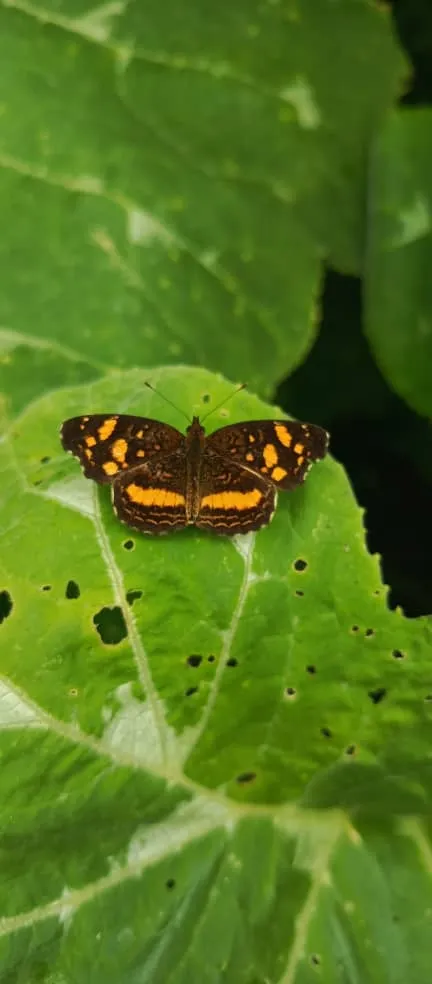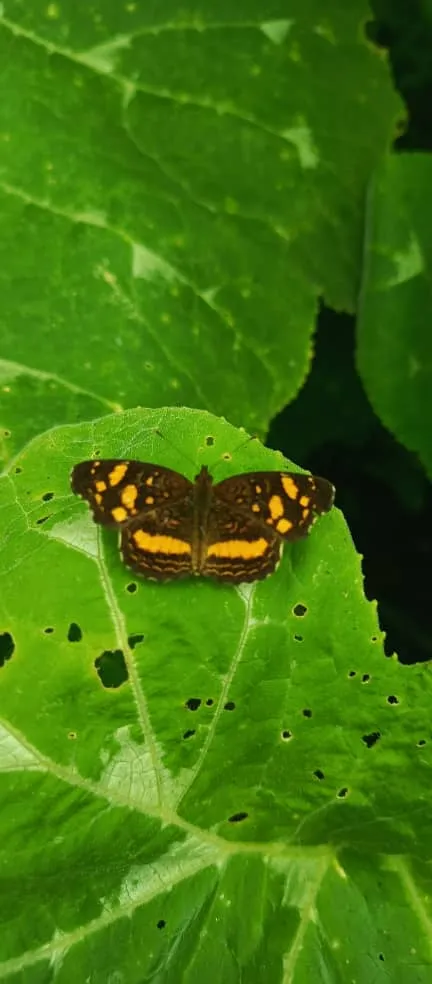

Bienvenidos

Welcome
Hola amigos de Hive!
Nuevamente me encuentro por acá en esta comunidad para comentarles que mientras caminaba por un sendero boscoso en el estado Mérida, por donde vivo, la naturaleza me regaló un momento que difícilmente olvidaré. Allí, entre la humedad del suelo y los rayos de sol que se colaban entre las hojas de los árboles, apareció una mariposa que parecía salida de una pintura: la Lunita de parche naranja (Smyrna blomfildia). Su nombre ya suena poético, pero verla en vivo es aún más sorprendente. Logré tomarle unas fotos mientras descansaba en una hoja, y aprovecho esta experiencia para compartir un poco más sobre esta especie fascinante.
Vale decir que apenas llegue a casa me dispuse con mi ordenador a buscarla para saber un poco más de ella, puesto que me llama la atención los insectos que me encuentro cada vez que salgo a caminar detrás de mi casa.
Esta mariposa pertenece a la familia Nymphalidae, una de las más diversas en el continente americano, se distribuye ampliamente desde el sur de México hasta el norte de Sudamérica, incluyendo países como Colombia, Ecuador, Perú y por supuesto, Venezuela, donde habita en bosques tropicales y subtropicales, especialmente en zonas montañosas como los Andes (https://en.wikipedia.org/wiki/Smyrna_blomfildia).
Otra particularidad es su comportamiento alimenticio. A diferencia de otras mariposas que se alimentan de néctar, los adultos de esta especie prefieren frutas fermentadas, excremento y savia, aprovechando su alto contenido de minerales y azúcares (https://pictureinsect.com/es/wiki/Anthanassa_ardys.html).
Aunque es una especie relativamente extendida en América tropical, su avistamiento no es común. Es posible que esto se deba a la pérdida de hábitats naturales, la fragmentación de los bosques y el cambio climático, factores que afectan directamente a mariposas y otros polinizadores. Por eso, cuando la vi en Mérida, comprendí que estaba presenciando un pequeño milagro.
Más allá de la emoción del avistamiento, este encuentro me recordó que la biodiversidad venezolana sigue siendo extraordinaria, pese a las muchas amenazas que enfrenta. La Lunita de parche naranja es solo una entre miles de especies que dependen de nuestros bosques, quebradas, cafetales y cultivos sostenibles para sobrevivir.
Observarla fue como leer una página viva de un libro natural. Ojalá más personas se detengan a mirar estos detalles, a cuidar nuestros ecosistemas y a valorar que, incluso en un rincón del bosque andino, una mariposa puede encender un fogonazo de color que nos devuelva el asombro.
Hello, Hive friends!
Once again, I find myself here in this community to tell you that while walking along a forest trail in the state of Mérida, where I live, nature gave me a moment that I will never forget. There, amid the damp soil and rays of sunlight filtering through the tree leaves, a butterfly appeared that looked like something out of a painting: the Orange Patch Moon (Smyrna blomfildia). Its name alone sounds poetic, but seeing it in person is even more amazing. I managed to take some photos of it while it rested on a leaf, and I am taking advantage of this experience to share a little more about this fascinating species.
It is worth mentioning that as soon as I got home, I sat down at my computer to look it up and find out a little more about it, since I am fascinated by the insects I encounter every time I go for a walk behind my house.
This butterfly belongs to the Nymphalidae family, one of the most diverse in the Americas. It is widely distributed from southern Mexico to northern South America, including countries such as Colombia, Ecuador, Peru, and, of course, Venezuela, where it inhabits tropical and subtropical forests, especially in mountainous areas such as the Andes (https://en.wikipedia.org/wiki/Smyrna_blomfildia).
Another peculiarity is its feeding behavior. Unlike other butterflies that feed on nectar, adults of this species prefer fermented fruit, excrement, and sap, taking advantage of their high mineral and sugar content (https://pictureinsect.com/es/wiki/Anthanassa_ardys.html).
Although it is a relatively widespread species in tropical America, sightings are uncommon. This may be due to the loss of natural habitats, forest fragmentation, and climate change, factors that directly affect butterflies and other pollinators. So when I saw it in Mérida, I realized I was witnessing a small miracle.
Beyond the excitement of the sighting, this encounter reminded me that Venezuela's biodiversity remains extraordinary, despite the many threats it faces. The orange-patch moon moth is just one of thousands of species that depend on our forests, streams, coffee plantations, and sustainable crops to survive.
Observing it was like reading a living page from a natural history book. I hope more people will stop to look at these details, to care for our ecosystems, and to appreciate that, even in a corner of the Andean forest, a butterfly can spark a flash of color that restores our sense of wonder.



Gracias por leer y votar este post...
Un abrazo!
Hasta otra oportunidad!
Thank you for reading and voting this post...
A hug!
See you again!
Los separadores fueron hechos con Canva.
The dividers were made with Canva.
Para este post me apoye en Translated with www.DeepL.com/Translator (free version)
For this post I relied on Translated with www.DeepL.com/Translator (free version)
Nota: todas las imágenes son de mi propiedad, tomadas con mi movil Infinix Hot 40
Note: all images are my property, taken with my Infinix Hot 40 mobile phone.
